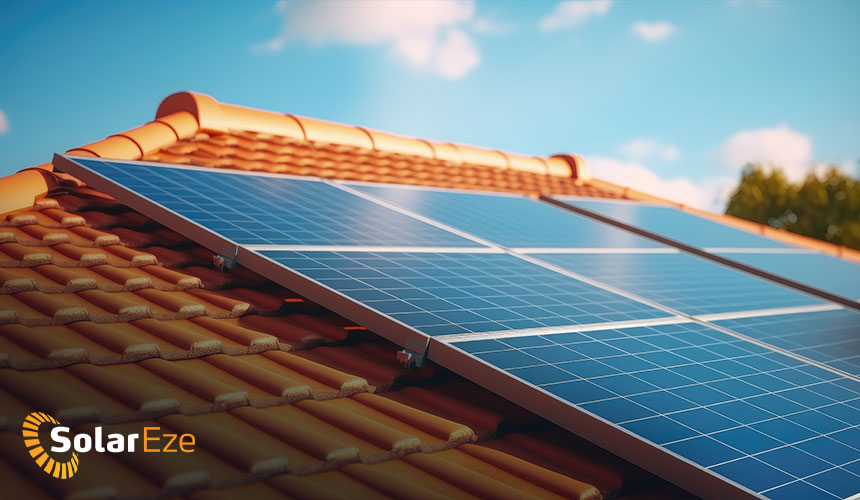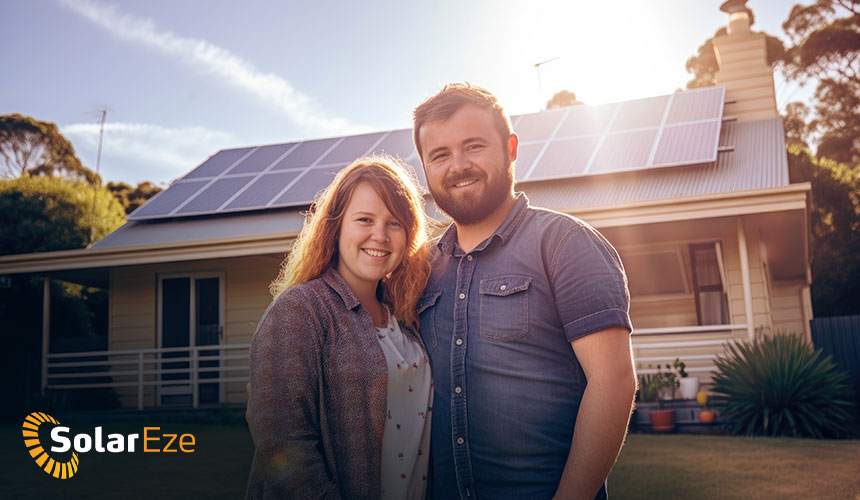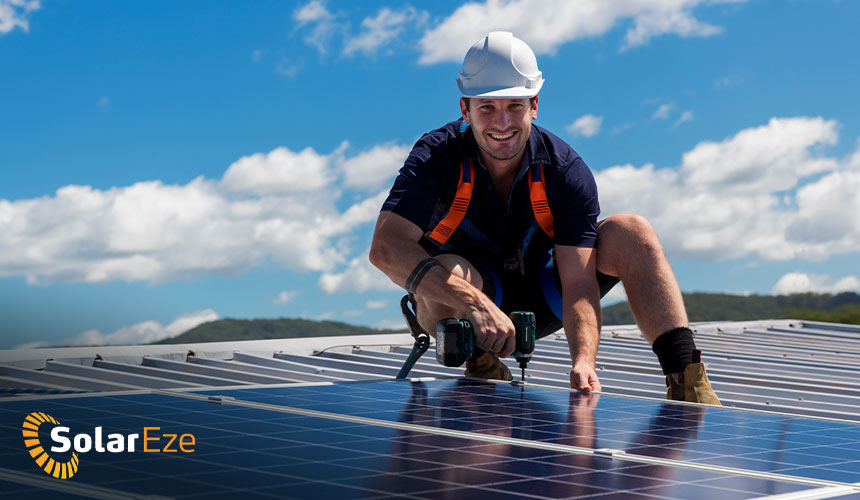Post-Installation Guide: What Should You Do After Installing Solar Power
Unleash the full potential of your new solar power system! Discover essential tips and tricks for post-installation in our enlightening guide.
15+ Years Experience
Financing Available
10 Years Warranty
CEC Qualified Installers
Key Takeaways
- Maximise the use of solar energy by making small changes and embracing energy tech such as setting timers for appliances, charging devices during the sunniest parts of the day, and running pool pumps during midday.
- Understand and manage your electricity consumption by using apps to monitor solar production, tracking solar data throughout the year, and checking electricity bills for information on solar energy consumption.
- Maintain your solar panels by keeping them clean, free from dust and debris, and ensuring they are not shaded by tree branches. Regular cleaning and following manufacturer’s instructions for maintenance are important.
- Consider additional factors such as guidelines for maximising your solar investment, meter change and grid connection, feed-in tariffs, protection for your solar system through insurance coverage, reading your inverter to track solar generation, and the option to upgrade your system if needed.
Post-Installation Inspection
After your solar panels are installed, don’t just kick back and relax! You’ve got to make sure they’re working harder than a line of ants at a picnic.
Check solar panel performance: On a sunny day, be eagle-eyed and inspect the system’s performance. Look out for any underperforming panels – they’ll stick out like a sore thumb in an otherwise efficient system.
Check your roof for damages: Don’t forget about the roof either – it’s not all about the shiny new panels! Give your tiles or tin roofing a thorough inspection for any cracks, leaks or damages caused during installation. If you see any creases on tin roofs or cracked tiles, get them fixed promptly to prevent further issues down the line.
Include your solar panels on your home and content insurance: Now let’s talk insurance coverage. Your solar panel investment needs protection too. Ensure your home insurance policy covers these new additions; if not, time to give them a call!
Regular maintenance by solar repair professionals: Of course, there’s also maintenance to consider. Regular panel cleaning is crucial as dirt build-up can reduce energy yield by up to 2.5%. Consider professional cleaning services every two years for optimal results.
Moving forward from here involves understanding how smart meters work.
Meter Change Process
Let’s delve into the process of changing your meter, an essential step in maximising the benefits of your newly installed solar system.
The very act of installing a solar system necessitates a change from your traditional accumulation meter to a smart one. This new type of meter is instrumental in measuring how much electricity you’re feeding back into the grid through your solar panels.
The grid connection process involves notifying your energy distributor about the upgrade. It’s important to note that charges for this service are typically added to your electricity bill as ‘meter upgrade charges’. Don’t worry, though – with feed-in tariff rates helping reduce costs and potentially earning you credits, these initial expenses will be offset in time.
While dealing with these technical details, don’t forget about insurance coverage for your upgraded setup! Adding solar panels can increase property value and replacement cost; ensure they’re included under home insurance. Simultaneously, keep track of system performance monitoring via smart meters and inverter displays.
Having sorted out all this, you are now poised to gain further by securing competitive feed-in tariff rates – an important factor influencing return on investment for any solar power installation.
Securing Competitive Feed-in Tariff
Securing a competitive feed-in tariff is absolutely crucial when it comes to maximising the return on your investment in a solar system. Understanding net feed-in tariffs and how they work can be key to optimising your solar energy savings. These tariffs are essentially the rates paid for electricity you generate and export back to the grid from your solar panels.
Feed-in tariff rates vary across states and retailers, so comparing retailer rates becomes essential in this scenario. When looking for competitive rates, remember that every cent matters – even a few cents difference per kilowatt-hour can significantly impact your annual returns.
Maximising solar exports should be one of your main goals after installing solar power. The more energy you export back to the grid, the more money you save off your electricity bill. It’s important to keep in mind that feed-in tariff rates are generally lower than retail electricity prices, meaning you’ll always make more money by using the electricity yourself rather than exporting it.
As you strive for optimal use of solar energy and seek ways to maximise savings, also consider updating your insurance policy accordingly – but we’ll delve deeper into that in our next discussion.
Insurance Adjustments
Once your new solar system is up and running, it’s vital to factor in insurance adjustments. Remember, your home’s value has likely increased with the installation of a solar power system.
This means updating coverage becomes necessary to avoid underinsurance risks. You don’t want to find yourself without adequate protection if an unexpected event damages your new investment.
Here are three crucial points to consider:
- Policy Adjustments: Contact your insurer immediately after your solar panel installation. Discuss the changes made to your property and ensure they update your policy accordingly.
- Insurance Premiums: Be prepared for possible changes in insurance premiums due to the increase in property value from installing a solar power system.
- Underinsurance Risks: Underinsurance can lead to significant financial loses if disaster strikes; therefore, make sure that the sum insured reflects the accurate replacement cost of both, house and solar panels.
Keep an eye on these aspects while making insurance adjustments post-solar installation – you’ll thank yourself later!
Next up? Ensuring you’ve scheduled maintenance for your new equipment – because a well-maintained system is key to reaping maximum benefits from this green energy source.
Scheduled Maintenance
Maintaining your new system on a regular basis isn’t just important, it’s essential to keep those energy savings rolling in! Solar panel cleaning is integral to the effectiveness of your setup. Over time, dust and debris can accumulate on the panels, reducing their ability to absorb sunlight efficiently and compromising the overall performance of your solar power system.
Don’t underestimate professional solar maintenance services when it comes to optimising your system’s performance. These experts are skilled at diagnosing underperforming parts and making necessary adjustments or replacements. They’ll also ensure all connections are secure for uninterrupted power flow, doing everything possible to maximise energy generation.
Your solar panel warranties might be voided without proper maintenance – another reason why you should schedule regular checkups for your system. Remember that these warranties protect you against manufacturing defects or issues that may arise over time and could potentially cost you plenty in repairs if not covered.
Making sure your panels are working at peak efficiency is what will really make a difference in those electricity bills! So, while scheduled maintenance might seem like an added chore, think of it as an investment towards maximising returns from your green initiative.
Now let’s move onto understanding the importance of customer service after installing solar power systems!
Valuing Customer Service
It’s essential to remember that a stellar customer service experience can make all the difference in your journey towards sustainable living. Now that you’ve installed solar power, the importance of service becomes even more apparent. The solar industry is complex and navigating through it requires knowledgeable and responsive customer service.
The quality of this service directly impacts your overall solar experience. From understanding how to maintain your panels for optimal performance, to troubleshooting any issues that might arise – an attentive customer support team is invaluable. They can provide clear explanations and solutions, ensuring you get the most out of your investment.
Customer satisfaction should be at the heart of every interaction with your solar provider. A company committed to exceptional service will not only help address immediate concerns but also anticipate potential challenges in the future. This dedication fosters trust and confidence, making you feel valued as a client.
Remember, adopting solar power is about more than just harnessing renewable energy; it’s about partnering with a provider who genuinely cares about your needs. So always prioritise great customer service because its impact goes beyond solving problems – it guarantees a smoother transition into greener living.
Frequently Asked Questions about Solar Installations
How can I monitor the amount of energy my solar panels are producing?
The advent of modern technology and smart applications has made it easier than ever to monitor the performance of your solar panels. A central component of your solar system is the inverter. Think of it as the brain of your solar operation. This device converts the direct current (DC) energy generated by your solar panels into alternating current (AC) energy for home use.
Many modern inverters come with built-in monitoring systems accessible through a dedicated app or website. By logging into this app or website, homeowners can gain valuable insights into the efficiency of their solar panels. Here’s what you can expect:
- Panel Efficiency: See at a glance how well each panel is performing. Are they all producing energy as expected, or are there any under-performing? Monitoring allows you to catch potential issues early.
- Peak Production: Learn when your panels are producing the most energy. This could be useful data if you’re considering battery storage or want to optimise the use of appliances during peak production hours.
- Energy Storage: For those with battery backup systems, the inverter app often displays how much energy is stored and available for use during times when the sun isn’t shining.
It’s worth noting that while the inverter app provides a wealth of data, it’s essential to ensure you have a reliable internet connection. This connection allows the inverter to send data to the app or website for your viewing.
If you don’t have an inverter with these capabilities, third-party monitoring solutions can be integrated with your system.
How does weather or seasonal changes affect the performance of my solar panels?
The performance of solar panels is intricately linked with weather and seasonal changes. As the year progresses and we move from one season to another, various factors come into play that can impact the efficiency and output of your solar panels.
- Seasonal Efficiency Fluctuations: As the earth’s tilt and orbit change with the progression of the year, the intensity and angle of sunlight received by solar panels also vary. For instance, during winter, the sun is lower in the sky in Australia, leading to shorter days and reduced solar exposure. Consequently, panels might produce less energy compared to longer, sunnier summer days.
- Shade Effects: Seasonal changes can lead to different shading patterns, especially in areas with deciduous trees. As leaves fall in autumn, solar panels previously shaded might receive more direct sunlight, whereas the spring growth can bring about new shading issues. Any obstruction that casts a shadow on the panels, even if temporary, can reduce energy production considerably.
- Temperature’s Role in Efficiency: It’s a common misconception that solar panels require heat to produce energy. In reality, they thrive on sunlight, not heat. Surprisingly, higher temperatures can adversely affect solar panel efficiency. As temperatures rise, the conductivity of the semiconductors within the panels decreases, leading to reduced power generation. So, while sunny summer days can be great due to longer daylight hours, extremely high temperatures can offset some of those gains. Conversely, solar panels can be more efficient in cooler temperatures, provided they receive adequate sunlight.
It’s essential to understand these nuances to set realistic expectations for your solar system’s output throughout the year. If you reside in an area with pronounced seasonal changes, consider these factors when calculating annual energy production. By being aware of these influences, you can better manage your energy usage and savings.
Are there any government incentives or rebates available for installing solar power?
Absolutely! In Australia, the government at both federal and state levels recognises the importance of transitioning to renewable energy sources. As such, they have implemented various incentives and rebates to encourage homeowners and businesses to make the switch to solar power.
- Federal Grants and Tax Credits: At the national level, Australia offers incentives like the Small-scale Renewable Energy Scheme (SRES). Under SRES, individuals and small businesses can receive Small-scale Technology Certificates (STCs) for every megawatt-hour of renewable energy they’re projected to produce or offset. These STCs can be sold or assigned to agents in exchange for a discount on your solar installation, effectively reducing the upfront cost.
- State Incentives: Each state and territory in Australia may have its own additional incentives for residents and businesses looking to adopt solar power. These might include rebates, low-interest loans, or feed-in tariffs that pay you for the surplus energy your solar system feeds back into the grid. For example, Victoria has been known to offer a solar panel rebate for homeowners, landlords, and renters.
- Utility Rebates: Some local utility companies offer rebates to customers who install solar panels. These rebates are designed to reduce the load on the grid, especially during peak hours, and can help offset the cost of your solar installation.
- Eligibility Criteria: It’s crucial to note that each incentive or rebate program will have its own set of eligibility criteria. These could be related to the size of your solar installation, the type of equipment you use, or other factors. It’s always a good idea to research each program thoroughly and consult with your solar provider to ensure you meet all the necessary requirements before applying.
In summary, Australia is proactively supporting the transition to renewable energy by offering a range of incentives and rebates. If you’re considering installing solar panels, make sure to explore all available options to maximise savings and return on investment.
How long is the warranty period for my solar panels and what does it cover?
Solar panels are a significant investment, and thankfully, manufacturers typically offer substantial warranties to provide consumers with peace of mind. Here’s what you need to know:
- Duration of Warranty: Most solar panels come with a warranty that lasts for around 25 years. This lengthy period speaks to the durability and longevity of solar panels, which are designed to withstand the test of time and various environmental conditions.
- Coverage: Solar panel warranties usually cover two main areas:
- Performance Warranty: This ensures that the panels will not degrade or lose their efficiency beyond a specified rate each year. For instance, a common performance warranty might guarantee that after 25 years, the solar panels will still produce at least 80-85% of their rated capacity.
- Product Warranty: This covers any defects in materials or craftsmanship. If a panel fails or shows abnormal degradation due to manufacturing faults within the warranty period, the manufacturer will repair or replace the defective panels, covering the associated costs.
- Warranty Extensions: Some manufacturers might offer warranty extensions, either as a paid option or a promotional benefit. The availability and terms of such extensions will vary based on the manufacturer’s policies and dependability.
- Claiming Warranty: It’s crucial to maintain a clear record of your solar panel purchase, installation, and any potential issues that arise. If you notice any decline in performance or detect any visible defects, promptly address them with your installer or the manufacturer. Many warranties require issues to be reported within a specific timeframe after noticing the defect.
- Additional Considerations: It’s worth noting that while the panels themselves have long warranties, other components of a solar system, like inverters or batteries, might have shorter warranty durations. It’s always good to be clear on the warranty details of each component in your solar system.
What should I do in case of a power outage, will my solar panels still generate electricity?
Power outages can raise valid concerns about your solar panel system’s functioning. Here’s what you need to know:
- Grid-Tied Systems: Most residential solar panel systems are grid-tied, which means they are connected to the local electricity grid. For safety reasons, these systems are designed to automatically shut down during power outages. This is a precautionary measure to ensure that electricity isn’t being fed back into the grid, which can endanger utility workers trying to restore power.
- Standalone Systems with Backup Batteries: If you have a solar panel system equipped with backup batteries, you’re in a more favorable position during power outages. Even if the grid goes down, your solar panels can charge the batteries, which can then provide electricity to your home. This kind of system offers the advantage of energy independence, but it’s crucial to ensure that the batteries are well-maintained and in good working condition.
- Power Surge Protection: Whether or not you have backup batteries, it’s essential to have surge protection in place. When power is restored after an outage, it can sometimes come with voltage fluctuations, which can damage your solar inverter or other electrical appliances. Surge protectors can help shield your equipment from these spikes in voltage.
- Regular Maintenance: To ensure that your solar system performs optimally, especially during crucial times like power outages, stick to a regular maintenance schedule. This includes checking the health of your batteries, cleaning solar panels, and ensuring that all system components are functioning correctly.
- Post-Outage Procedures: Once power is restored, if you have a grid-tied system, it will typically start generating electricity and feeding it back into the grid automatically. However, it’s a good practice to check your inverter and other system components to ensure everything is operating correctly.
In summary, while grid-tied solar systems won’t generate electricity during a power outage, systems with backup batteries will continue to provide power. Regardless of your setup, always prioritise safety, invest in surge protection, and maintain your solar equipment to ensure it’s ready to serve you when you need it most.
Conclusion
So, you’ve installed your solar power system – that’s just the beginning. Like a well-oiled machine, regular inspections and maintenance keep it running smoothly. Switch to a smart meter, hunt for the best feed-in tariff and add the panels to your home insurance. Don’t forget about good customer service from your provider and routine professional cleanings. Keep monitoring your system performance – it’s essential to maximising your bright solar investment.
Visit www.solareze.com.au to request a quote for your next solar installation and one of our friendly team members will contact you shortly. If you would like to talk to us immediately, call 0410 658 790 today and we will offer you a free solar consultation for your home.







No Comments